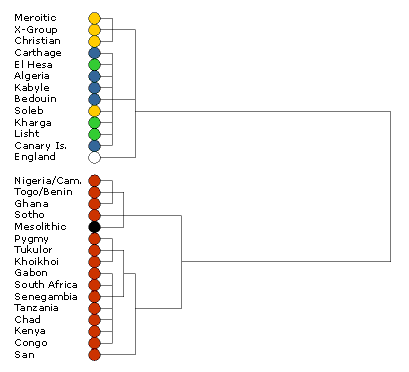|
One of the most common ways of assessing population relationships has been the comparative analysis of skull types. Such a study was carried out by the physical anthropologist C. Loring Brace and five co-researchers (Brace et al., 1993) who statistically analyzed a range of 24 cranial measurements from diverse world samples, including ancient Egyptians. The results of the analysis suggest that ancient Egyptian crania had elements in common with those from Southwest Asia and Neolithic Europe, as well as North and Northeast Africa. However, the Egyptian skulls showed very little similarity to African crania from the more distant south and west. The plot below shows, as accurately as is possible in two dimensions, the relationships between craniofacial configurations of the various regional samples. The predynastic sample from Upper Egypt lies very close to the West Eurasian group but also shows tendencies toward some neighboring African groups; this should not be surprising given Egypt's geographical position near the crossroads of Africa, Asia, and Europe. The northern Egyptians deviate even more strongly from the tropical African pattern, and indeed their closest relatives appear to be western Eurasians and coastal North Africans. Notice that the pooled group of Sub-Saharan Africans from the southern, central, and western regions of the continent does not resemble Egyptians at all: this group is plotted very distant from both ancient Egyptian samples. Similar conclusions are reached by Howells (1989, 1995) and Froment (1992, 1994)
|
Figure 1. Multidimensional scaling plot based on a suite of 24 cranial measurements taken from samples of 25 world populations. (Details , rotatable 3D plot)
The analysis of discrete dental traits is often used to determine biological relationships of populations using dental remains. The recent work of JD Irish (Irish 1997, 1998a, 1998b) examines several African popuations and concludes that Egyptian populations show more dental similarity to modern North Africans, Arabs, and even Europeans, than to Sub-Saharan Africans. The diagram below (adapted from Irish, 1998b) shows the results of a statistical cluster analysis. It demonstrates that ancient Egyptian dental configuration resembles that of recent North Africans, rather than sub-Saharan Africans. The appearance of Nubian groups in the North African cluster may seem surprising at first, but this may well be due to proximity and gene flow with neighboring North African peoples. Indeed, other North African traits have been found in some Nubian groups as well — in genetics (Cavalli-Sforza et al. 1994, Krings et. al 1999), and hair Hrdy (1978) — although of course Nubians in general show significantly stronger sub-Saharan influences than do Egyptians.

Figure 2: Cluster dendrogram. green: Egyptians; blue: Mediterranean North Africans; yellow: Nubians; white: England; red: sub-Saharan Africans; black: Mesolithic Nubians.
Numerous mummies with hair still attached to the skulls show that straight, wavy, or lightly curled hair types were common in ancient Egypt. For example, in a study (Titlbachova and Titlbach, 1977) involving detailed microscopic investigation of hair samples taken from several ancient Egyptian mummies, most were determined to have been naturally straight, wavy, or gently curled, with a roundish cross-section typical of modern Eurasian and North African peoples. Only a minority showed evidence of structural characteristics traditionally called "Negroid"; even in these the "Negroid" elements were weakly manifested.
Joann Fletcher, a consultant to the Bioanthropology Foundation in the UK, in what she calls an "absolute, thorough study of all ancient Egyptian hair samples" — relied on various techniques, such as electron microscopy and chromatography to analyze hair samples (Parks, 2000). She discovered that most of the natural hair types and those used for hairpieces were made of what she calls "Caucasian-type" hair, including even instances of blonde and red hair. Fletcher surmises that some of the lighter hair types may have been influenced by the presence of ancient Libyans and Greeks in ancient Egypt. However, this type of hair was also found to be present in much earlier times.